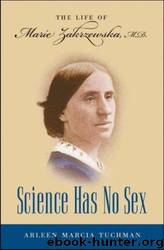Science Has No Sex by Arleen Marcia Tuchman

Author:Arleen Marcia Tuchman [Tuchman, Arleen Marcia]
Language: eng
Format: epub
Tags: Biography, The University of North Carolina Press, ISBN-13: 9780807830208
ISBN: 9780807830208
Goodreads: 1042428
Publisher: University of North Carolina Press
Published: 2006-05-01T00:00:00+00:00
The Hospital in Transformation
When the doors of the New England Hospital for Women and Children opened in June 1862, it was a small, charitable operation. Located in a rented house in central Boston, it had just ten beds at its disposal, one resident physician, two consulting physicians, and two student interns. The New England admitted an average of about 130 patients a year in the first years of its existence, the vast majority for childbirth or ‘‘diseases of women,’’ and attended to approximately 1,500 patients more through its dispensary practice. The annual reports of the hospital in these early years repeated much the same message Zakrzewska had spelled out in her 1863 lecture, keeping their focus on the necessity of providing a safe haven for the poor and destitute, including unwed mothers. Declaring
‘‘absurd’’ the idea that a lying-in hospital could ever foster immorality, Zakrzewska insisted that every laboring woman, with no exceptions, ‘‘must in the hour of trial be sheltered and cared for.’’ Clearly not having lost any of her radicalism, she urged her supporters to consider the plight of the destitute and respond not only with ‘‘sentiment or sentimental sympathy’’ but also with ‘‘gold.’’∞
By the end of the century, the New England Hospital was a totally di√erent enterprise. With a capacity of roughly ninety beds, it averaged just over 800
patients a year in the first years of the new century and another 17,700 through its dispensary. It had also abandoned the inner city in 1872, moving out to the suburbs of Roxbury close to Zakrzewska’s home. Over the years it expanded to include a new maternity building (1892), a new dispensary (1896), a new surgical building (1899), and a renovated central building, which housed the medical wards. The dispensary, which remained in the inner city, was divided into six separate clinics, one each for gynecology, medicine, surgery, skin, eye, and throat, nose, and ear. The sta√ consisted of one resident physician; twenty-
THE HOSPITAL IN TRANSFORMATION
178 ≤
four advisory, attending, and assisting physicians at the hospital; another thirty attending and assisting physicians at the dispensary; and thirteen consulting physicians.≤
With this expansion came a change in the rhetoric of the annual reports as well. Gone was any explicit concern with poor unwed mothers, even though they continued to make up roughly 20 percent of the maternity patients. Instead, the hospital proudly announced that the vast majority of its maternity patients were married; indeed, many of them owned their own homes but preferred to deliver in the hospital because they lacked the ‘‘quiet and freedom from responsibility’’ they needed during childbirth. The reports on the medical and surgical wards followed a similar trend; whereas earlier ones emphasized the importance of a dignified setting for ‘‘the wives of clergymen in the country’’
and ‘‘school teachers, worn out by their arduous labors,’’ later ones focused on creating an environment where ‘‘those who have good homes and the command of all that wealth can procure still find their best chance of recovery.’’≥
The New England Hospital had been almost completely transformed.
Download
This site does not store any files on its server. We only index and link to content provided by other sites. Please contact the content providers to delete copyright contents if any and email us, we'll remove relevant links or contents immediately.
Hit Refresh by Satya Nadella(9013)
When Breath Becomes Air by Paul Kalanithi(8292)
The Girl Without a Voice by Casey Watson(7801)
A Court of Wings and Ruin by Sarah J. Maas(7618)
Do No Harm Stories of Life, Death and Brain Surgery by Henry Marsh(6875)
Shoe Dog by Phil Knight(5105)
Hunger by Roxane Gay(4854)
The Rules Do Not Apply by Ariel Levy(4822)
A Higher Loyalty: Truth, Lies, and Leadership by James Comey(4820)
Tuesdays with Morrie by Mitch Albom(4660)
Everything Happens for a Reason by Kate Bowler(4657)
The Immortal Life of Henrietta Lacks by Rebecca Skloot(4500)
Millionaire: The Philanderer, Gambler, and Duelist Who Invented Modern Finance by Janet Gleeson(4351)
How to Change Your Mind by Michael Pollan(4273)
All Creatures Great and Small by James Herriot(4211)
Man and His Symbols by Carl Gustav Jung(4055)
The Money Culture by Michael Lewis(4050)
Elon Musk by Ashlee Vance(4007)
Tokyo Vice: An American Reporter on the Police Beat in Japan by Jake Adelstein(3922)
